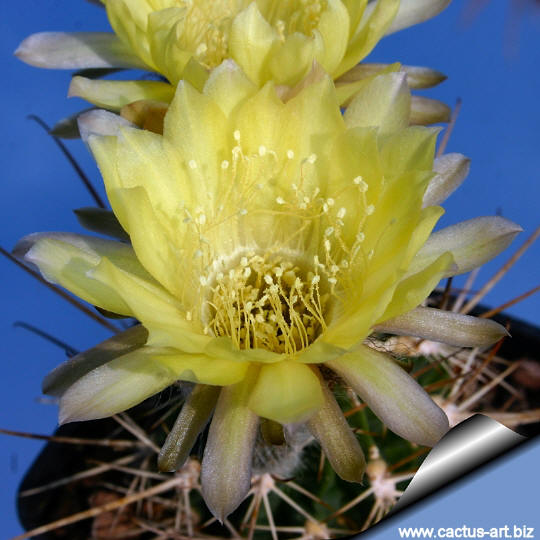|
|
|
Family:
Cactaceae (Cactus
Family)
Lobivia lateritia v. citriflora W. Rausch
In: Succulenta (Amsterdam) 59 (2):
29-30,
1980
Accepted
Scientific name:
Echinopsis lateritia Gürke
In: Monatsschr. Kakteenk. XVII. 10. p. 151-152. 1907
Origin: Potosi, (Southern Bolivia)
Type location close Talina. Altitude 3300-3500 m
Conservation status: Listed in
CITES appendix 2.
Synonyms:
-
Lobivia lateritia
(Gürke) Britton & Rose
In: Cactaceae 56,1922.
The
Echinopsis lateritia complex
comprises a large number of infraspecific
taxa, differing in various combinations of flower colour, spine
colour, number and thickness of central spines, and other characters.
The taxonomic and geographic boundaries among the segregate species or
infraspecific taxa of E. lateritia remain nebulous and
controversial. In no place do pure populations exist
sympatrically, and all taxa appear completely interfertile.
|
|
Description: Lobivia
lateritia var citriflora is a pretty species, with a low thick flat to
cylindrical stem 15 cm high and 9 cm thick. Plant almost always grows
solitary but sometime ramifies from the base to form clusters.
Root: Tap root.
Ribs: About 18, broad at the base, acute straight, approx
1 cm high.
Areoles: Felted1-2 cm apart.
Radial spines: 9-10 straight interlaced horizontally with
one another, up to 5 cm
long, whitish, yellowish or brownish.
Central spines: 1 to 2 ± longer than the radials curved upward,
somewhat thickened at the base sometime slightly hooked. Older plant
begins to produce very long spines (up to 10 cm in some clones)
Flowers: Short funnel-formed 3 to 5 cm long, 5-6 cm in diameter,
the name "citriflora" means "lemon-like flower"
and refers to the lemon-yellow or whitish-yellow colour of the blooms.
colour) that are usually clearer at centre. Inner perianth segments oblong, acute. Scales on the
ovary and flower tube lanceolate, acute with dull-white hairs in the axil.
Filaments yellow, anthers yellowhis-white. Stigma lobes about 7 or 8.
Blooming season: Bloom in the daytime, from late spring to summer
and remain open for about three days.
Fruit and seed: Similar to the
Lobivia lateritia var. kupperiana.
|
|
|
|

Photo of
conspecific taxa, varieties, forms and cultivars
of plants belonging to the Lobivia
lateritia
complex
(This
Taxon has lots of synonyms
whit several controversial varieties and subspecies and comprises a
multitude of different forms, but where each form is linked to others by
populations of plants with intermediate characteristics):

 |
|